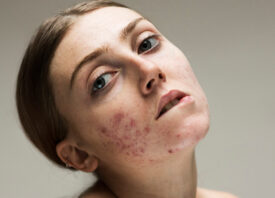Search this site
From Vitiligo to Birthmarks: The Beauty of Human Skin
Linda Hansen captures the beauty of birthmarks, and Julia Kaczorowska travels the world to tell the stories of people with vitiligo. Ariana Page Russell uses dermatographia, a skin condition that leaves her hypersensitive to touch, to create a new kind of art, and Fritz Liedtke uses photogravure to turn freckles into constellations. Anastasia Pottinger photographs the body at 101 years old, and Sophie Harris-Taylor champions skin positivity.

These Powerful Photos Challenge the Stigma Around Skin Conditions
“British photographer Sophie Harris-Taylor hopes to break down the stigma around skin issues with Epidermis, her candid new photo series challenging how we view imperfection.
“Epidermis features close-up portraits of 20 women from across the UK with varying skin conditions. The models pose in ways familiar from beauty shoots and celebrity Instagram snaps, except they wear no clothing or make-up – and there’s not an airbrush in sight.”

Behold the Beauty of Vitiligo
The Warsaw-based photographer Julia Kaczorowska first developed spots of white on the skin around her knees and elbows at the age of four when she was celebrating the holidays. She, like one to two percent of the world’s population, has vitiligo, a condition by which the flesh loses its pigment in certain areas.
As a child, the photographer was rarely made to feel self-conscious for her skin, but in adolescence, she found herself hiding her patches; at the beach, she says, she shielded her legs from view.
As an adult, Kaczorowska has learned not only to accept but also to treasure her white spots, to see them not as blemishes but as a kind of ornamentation. WZORY, which in Polish means both “designs” and “role model,” is her chronicle of and tribute to people with vitiligo, who despite the stigma that surrounds the condition, choose to bare all.

Photogravure Portraits Explore the Beauty of Freckle-Graced Faces
“For his series Astra Vellum, Fritz Liedtke sings the praises of ‘flawed human skin, with its freckles and scars, overlaid upon us like a thin veil of stars,’ for which the series was named. Hand-printed by Liedtke, he brings the images to luminescent life by photogravure, a technique all but lost to photography since the advent of silver-gelatin printing. The complicated intaglio process of photogravure relies heavily on texture, making it the perfect ally to compliment skin swathed in stars.”

The Beauty of the Aging Body, in Photos
Over the course of nine years, the Missouri-based photographer Anastasia Pottinger has worked with models over the age of one hundred years old. She’s spent time by their sides, listened to their stories, and recorded the details of their skin in black and white. Now, you can find her photographs of fourteen of these centenarians collected in the new book 100: What Time Creates, published by Marcinson Press.
Pottinger’s process is a collaboration with her subjects. It began with a woman named Lucy, then 101 years old, and spread throughout the United States with a diverse group of people wanting to be photographed. By the time they met the photographer, they were all at different stages in their lives; they could be living in a nursing home, living independently, or even traveling extensively. During the shoots themselves, the models were each invited to undress, but they chose how much to reveal. One woman chose to sit completely nude, and another man decided to stay almost totally clothed.

Portraits Of Remarkable Birthmarks Challenge Us To See Others Differently
“Copenhagen-based photographer Linda Hansen wants to challenge your notion of noticing others. In her new book, Naevus Flammeus, Hansen creates portraits of people born with a skin condition called nevus flammeus (also known as a port-wine stain), a congenital vascular malformation that results in a light pink to deep red birthmark that, for the most part, generally tends to appear as if red wine was splashed across a person’s face or neck. ‘I compare it to having a tattoo: It’s curious, or a special mark with history. It’s beautiful,’ Hansen said.”

Artist Explores Her Unusual Skin Condition In Mesmerizing Photographs
The Brooklyn-based photographer Ariana Page Russell has dermatographia, a skin condition that leaves her hypersensitive to touch, enabling her to lightly scratch her flesh to create raised welts in deliberate, elegant patterns. Russell’s mesmerizing images serve in part to catalog the invisible and nonverbal powers of the body. Where the intangible markers of human touch depart the skins of others within moments, Russell preserves them, first as scratches and then as photographic evidence.



